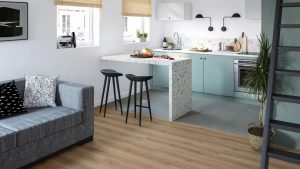Choosing the right flooring for smaller spaces can transform a cramped room into a stylish, open, and inviting area. The right flooring enhances aesthetics while creating an illusion of more space. Hardwood floor and rustic floor styles are particularly effective for small rooms, offering both elegance and practicality. This guide explores the best flooring options to make your compact spaces feel larger, brighter, and more cohesive.

Why Flooring Matters in Small Spaces
Flooring plays a critical role in small spaces, influencing how spacious and welcoming a room feels. Light colors, seamless designs, and strategic textures can make a room appear larger, while darker or overly busy patterns may shrink it visually. Hardwood floor options, with their clean lines and timeless appeal, are ideal for creating a sense of openness. Similarly, rustic floor styles add warmth and character without overwhelming compact areas, making them perfect for cozy apartments or small homes.
Top Hardwood Flooring Styles for Small Spaces
Hardwood floor is a top choice for smaller spaces due to its durability, versatility, and ability to reflect light. Light-toned hardwoods, such as oak or maple, brighten rooms and create a sense of airiness. Wide planks can elongate a space visually, while smooth finishes prevent visual clutter. A hardwood floor in a light or natural finish pairs well with minimalist furniture, enhancing the perception of space in small living areas or bedrooms.
Rustic Flooring for a Cozy Yet Spacious Look
A rustic floor brings warmth and texture to small spaces without sacrificing openness. Opt for lighter rustic floor styles, like distressed white oak or ash, to maintain brightness. The natural knots and grains of rustic flooring add character, but choosing a subtle, weathered finish prevents the space from feeling cramped. Pairing a rustic floor with neutral walls and simple decor ensures a balanced, inviting aesthetic that suits cozy nooks or tiny studios.
Other Flooring Options for Small Spaces
Beyond hardwood floor and rustic floor, other materials can enhance small spaces. Light-colored laminate or engineered wood mimics the look of hardwood at a lower cost, offering durability and easy maintenance. Porcelain tiles in large formats and light shades create a seamless, expansive look, ideal for small bathrooms or kitchens. Vinyl planks with a wood-like appearance provide a budget-friendly alternative that maintains the elegance of a hardwood floor while being water-resistant.
Design Tips for Flooring in Small Spaces
To maximize the impact of flooring in small spaces, consider these design strategies. Use consistent flooring throughout multiple rooms to create a unified, flowing space, avoiding visual breaks that shrink the area. Diagonal or herringbone patterns in hardwood floor installations can elongate rooms. For rustic floor styles, opt for matte finishes to reduce glare and maintain a soft, open feel. Keep furniture legs elevated to expose more floor, enhancing the sense of space.
Maintenance Considerations for Small Space Flooring
Maintaining flooring in small spaces is crucial to preserve its appearance and functionality. Hardwood floor requires regular sweeping and occasional polishing to maintain its shine, especially in high-traffic areas. A rustic floor with a distressed finish may hide minor scratches but needs protection from excessive moisture. For alternative materials like laminate or vinyl, use gentle cleaners to avoid damage. Regular upkeep ensures your flooring continues to enhance the space’s aesthetic and perceived size.
Factors to Consider When Choosing Flooring
When selecting flooring for small spaces, consider room function, budget, and lifestyle. Hardwood floor is durable but may require more upkeep, making it ideal for low-traffic areas like bedrooms. A rustic floor suits cozy spaces but needs careful finish selection to avoid overwhelming the room. Budget-friendly options like laminate or vinyl are practical for rentals or high-traffic zones. Ensure the flooring complements your decor to create a harmonious, spacious feel.
Conclusion
Selecting the best flooring for smaller spaces is about balancing style, functionality, and space-enhancing qualities. Hardwood floor options offer timeless elegance and light-reflecting properties, while rustic floor styles add warmth and character without compromising openness. By choosing light tones, seamless designs, and strategic patterns, you can transform compact spaces into stylish, inviting areas. Whether you opt for a classic hardwood floor or a charming rustic floor, the right choice will elevate your home’s aesthetic and make every square foot feel larger.




